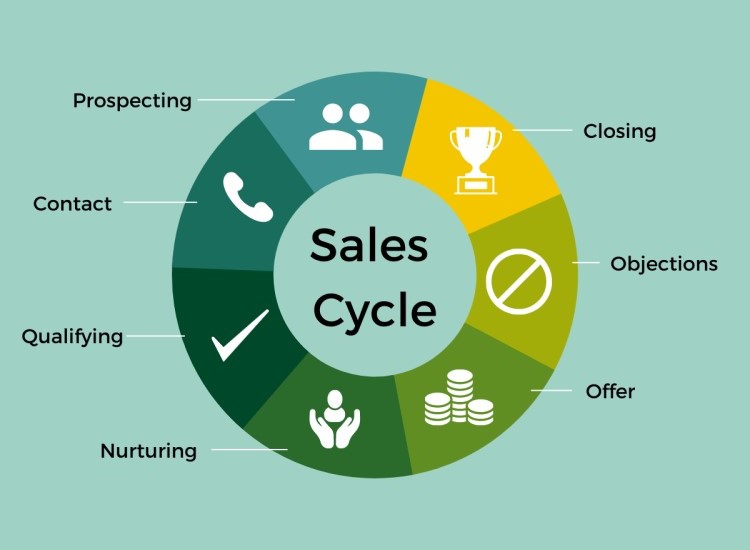
Stages of the Sales Cycle
Understanding the sales cycle is key to improving your sales process and closing more deals. The first stage is prospecting, where you identify potential customers who might be interested in your product or service. Effective prospecting fills your sales pipeline and sets the foundation for future success.
Once you have leads, the next stage is lead qualification. This involves determining whether the prospect is a good fit for your offering. Qualifying leads saves you time by focusing on those most likely to convert into paying customers.
The presentation stage follows, where you showcase your product or service. A good presentation addresses the prospect’s needs and highlights the value you offer. Next, you’ll likely face objections, which is a normal part of the process. Handling objections effectively requires addressing concerns and demonstrating how your solution solves the prospect’s problem.
Closing the deal is the final step, where you secure the commitment from the customer. However, the sales cycle doesn’t end there. Following up after the sale helps build long-term relationships and encourages repeat business. By fully understanding the sales cycle, you can streamline your approach and increase your overall sales success.
Prospecting and Lead Generation
Prospecting and lead generation are essential steps in understanding the sales cycle. These processes help you identify potential customers and fill your sales pipeline. One effective method is leveraging social media platforms to find prospects interested in your product or service. By engaging with users on platforms like LinkedIn or Instagram, you can identify and connect with potential leads who match your target audience.
Another approach is using email marketing to reach prospects directly. Sending personalized, relevant messages can capture the attention of leads and invite them to learn more. Building an email list through content offers or landing pages is an effective way to nurture potential customers.
Networking is also a powerful tool for lead generation. Attending industry events or joining online communities gives you access to prospects actively searching for solutions. This personal interaction helps build trust, making it easier to move prospects through the sales cycle.
By focusing on these methods, you can ensure a steady stream of qualified leads. Understanding the sales cycle starts with efficient prospecting, which lays the foundation for future sales opportunities. Effective lead generation helps you fill your pipeline with potential customers, increasing your chances of success.
Qualifying Leads: Identifying Opportunities
Qualifying leads is a critical step in understanding the sales cycle. Not every lead will become a paying customer, so it’s important to assess each one carefully. By qualifying leads, you determine if they have the budget, authority, need, and timeline to make a purchase. This process saves time and resources by focusing on the most promising opportunities.
To qualify leads, start by asking relevant questions to gauge their interest and ability to buy. For example, you might ask about their current challenges or their budget for solving the problem. This helps you prioritize which leads are worth pursuing and which may not be ready yet.
Prioritizing leads also involves considering how closely they align with your ideal customer profile. Leads that match your target market’s characteristics are more likely to convert into paying customers. By focusing on qualified leads, you improve your chances of closing deals and moving prospects smoothly through the sales cycle. In understanding the sales cycle, qualifying leads ensures you spend your time on opportunities with the greatest potential for success.
Effective Sales Presentations
Delivering an effective sales presentation is a key part of understanding the sales cycle. A successful presentation focuses on addressing your customer’s specific needs. Start by clearly identifying their problem and then presenting your product or service as the solution. This helps you engage the customer right away and keeps the conversation focused on their priorities.
Another important technique is to keep the presentation simple and clear. Avoid overwhelming your audience with too much information. Instead, focus on the value your product or service provides. Highlight key benefits, not just features, so the customer can see how it directly helps them. By doing this, you emphasize how your offering improves their situation.
Lastly, make your presentation interactive by asking questions and encouraging feedback. This makes the customer feel involved and helps clarify any concerns. It also allows you to tailor your pitch in real time, adjusting to the customer’s reactions. By mastering these techniques, you create a compelling presentation that moves prospects closer to a sale and enhances your understanding of the sales cycle.
Handling Objections and Negotiation
Handling objections is an important part of understanding the sales cycle. When a customer raises concerns, it’s an opportunity to address their doubts and build trust. A key strategy is to listen carefully to their objection. By understanding their concerns, you can respond with relevant solutions that help ease their worries.
One common objection might be pricing. In this case, emphasize the value your product or service brings, rather than focusing solely on the cost. Show how it solves their problem or improves their situation, making the investment worthwhile. This approach helps shift the focus from price to the benefits they receive.
Negotiation plays a significant role in reaching a deal that satisfies both parties. It’s important to stay flexible and open to compromise. Offer solutions that meet the customer’s needs while protecting your business’s interests. By maintaining open communication, you create a win-win situation. Handling objections and negotiating effectively builds trust, helps you close deals, and strengthens your overall understanding of the sales cycle.
The Importance of Follow-Up in Closing Deals
Following up is an essential part of understanding the sales cycle and closing deals. A timely follow-up shows your customer that you value their business and are committed to meeting their needs. Often, customers need a reminder or additional information before making a final decision, and follow-ups give you the chance to provide that support.
One key benefit of follow-ups is keeping the conversation active. After an initial meeting or proposal, some customers may hesitate or need more time to decide. By following up, you maintain momentum and demonstrate your reliability. It also allows you to address any lingering questions or objections that may have surfaced after your first interaction.
In addition to closing the immediate sale, follow-ups help build long-term relationships. Customers who feel valued are more likely to return for future business. Regular follow-up, even after the sale, fosters loyalty and keeps your brand top of mind. Consistent communication strengthens trust and ensures you remain a go-to resource for your customer. Understanding the sales cycle includes knowing that follow-ups can turn a single sale into a long-lasting partnership.
Conclusion
In conclusion, understanding the sales cycle is key to improving your sales process as well as closing more deals. Each stage, from prospecting to follow-up, plays a critical role. Focusing on qualifying leads, delivering effective presentations, and handling objections ensures you address your customers’ needs. Follow-ups, in particular, help maintain relationships and secure long-term loyalty. By mastering each part of the sales cycle, you can move prospects through the process efficiently and increase your overall success. Strengthening these skills will help you grow your business and also build lasting customer connections.


